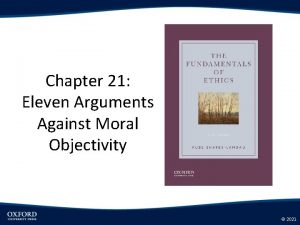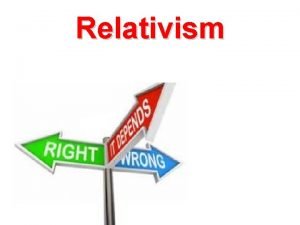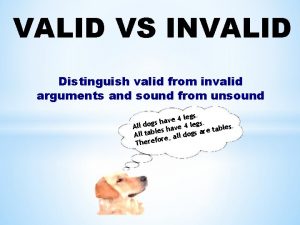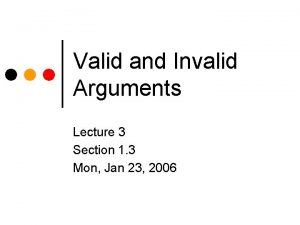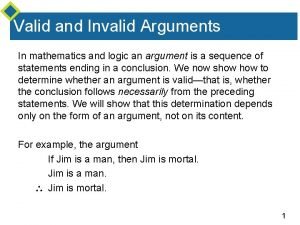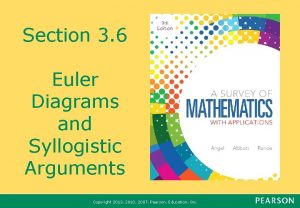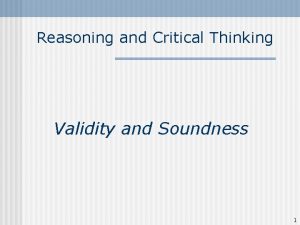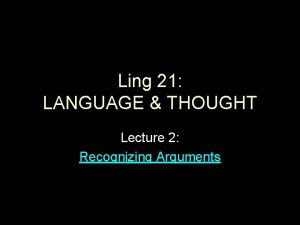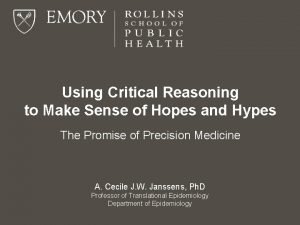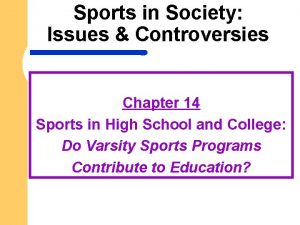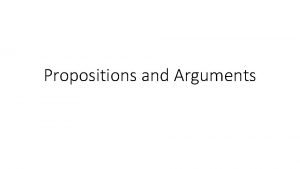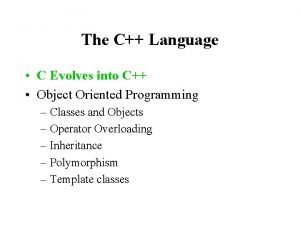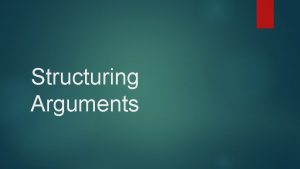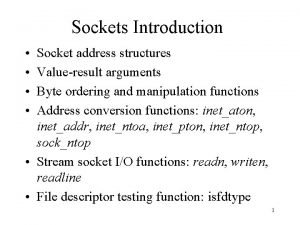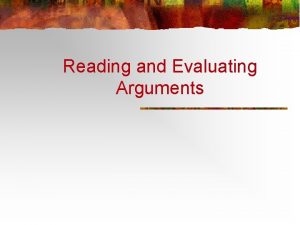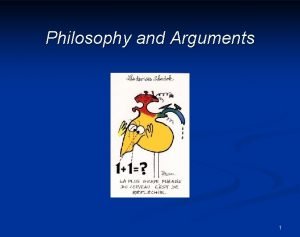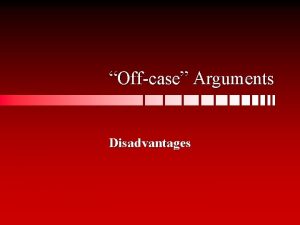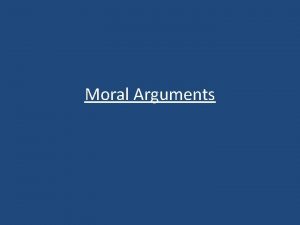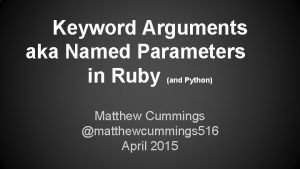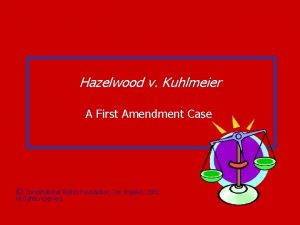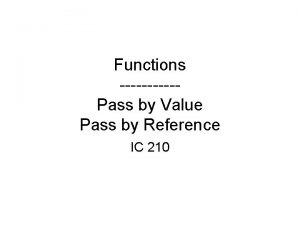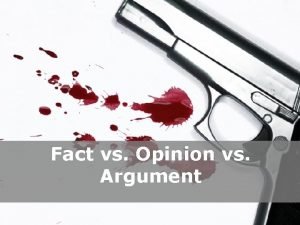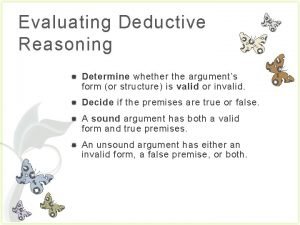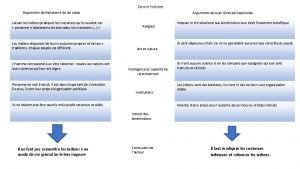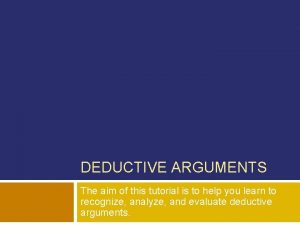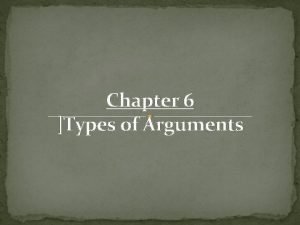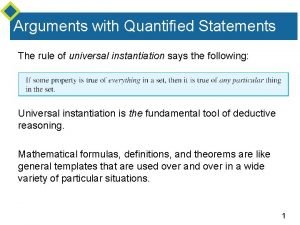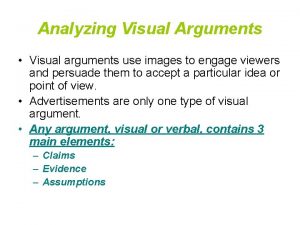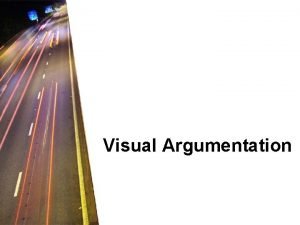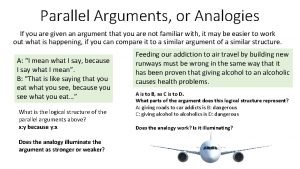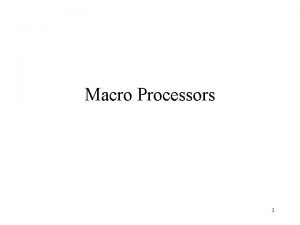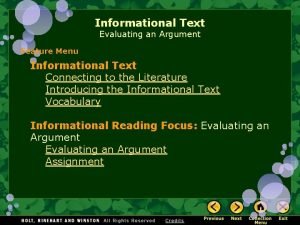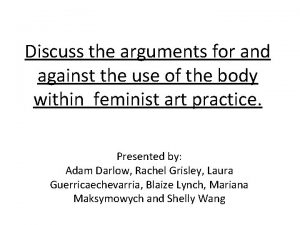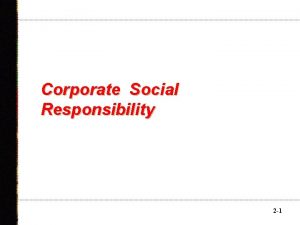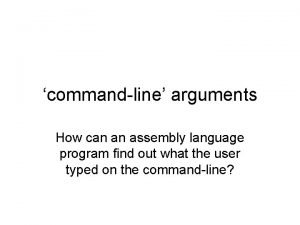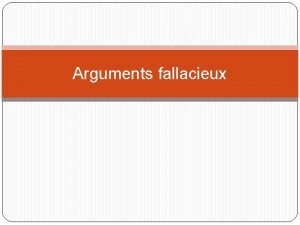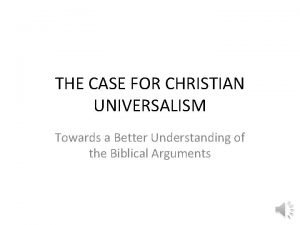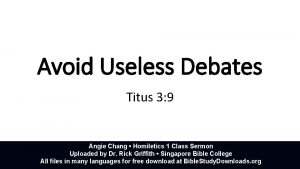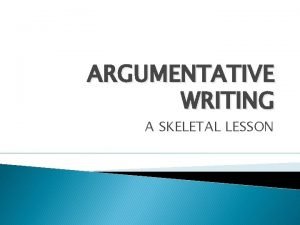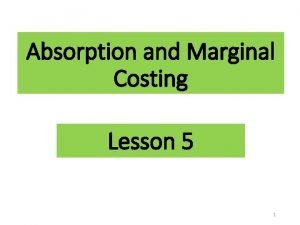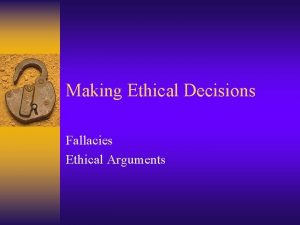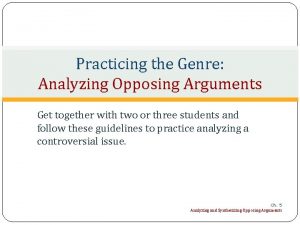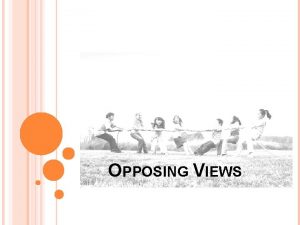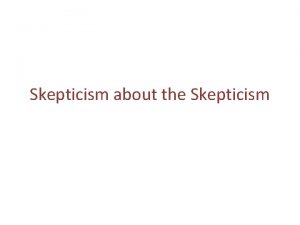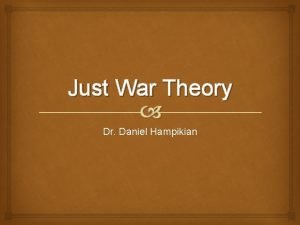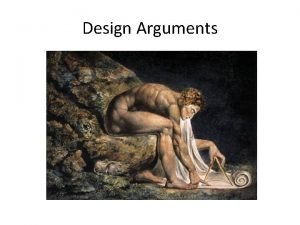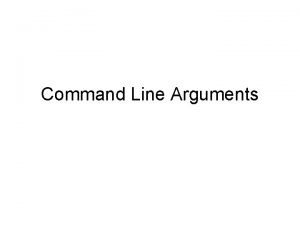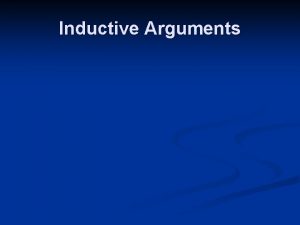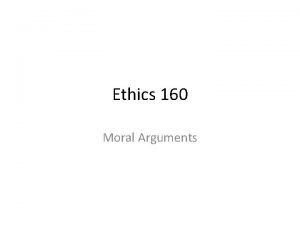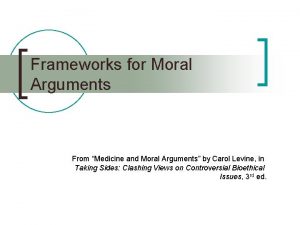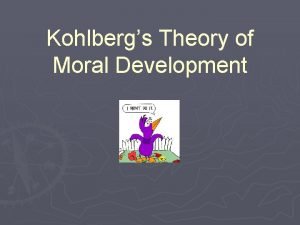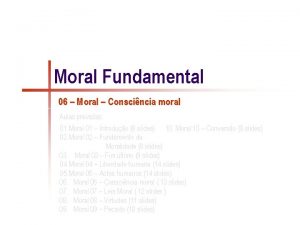Arguments and Moral Skepticism Daniel Hampikian Structure of










































































- Slides: 74

Arguments and Moral Skepticism Daniel Hampikian

Structure of the Class What an argument is (overview) Truth Validity and Soundness In Class Exercises: Determining Validity and Soundness Fallacies Induction Moral Skepticism

An argument is… Propositions Not the same as sentences: Cogito Ergo Sum, I think therefore I exist Premises Indicator words: since, because, for, if, follows from, given that, provided that, and assuming that Conclusion Indicator words: thus, therefore, hence, so, then, consequently, as a result, shows that, means that, implies that, establishes that, can be concluded that

Water slides can be peoplepreserving, or not…

IF people were to go in…

A circuit can be electricity preserving, or not…

Good and Bad Circuits

Like a good waterslide, a good argument preserves something… This is truth. A good argument is one where if the premises are true, it’s structure ensures that the conclusion will be true. Truth goes in and inevitably comes out of a good argument, just as people go in and inevitably come out of a good waterslide.

A good argument has these properties: Truth Logical Validity Not the same as truth If the premises are true… Without validity, an argument… Soundness Must be logically valid and the premises true, which guarantees the truth of the conclusion

Deductive Arguments: Truth Whether a statement is true is distinct from whether or not you or anyone else believes it. A statement is true just in case reality is the way that it describes. Truth is determined by objective states of affairs. (Assumes a theory of truth called the correspondence theory) Other considerations: True for me just means belief Self fulfilling prophecies

Categories of Arguments Deductive arguments: if the argument is sound, the conclusion is guaranteed to be true Inductive argument: if the argument is strong, the conclusion is probable or plausible Abductive arguments: if the explanation is the best possible explanation, then it is likely to be true.

Examples of deduction All cats are mammals All mammals are animals Therefore all cats are animals If morality is what God wills, then genocide would be moral if God willed it Genocide would not be moral if God willed it Therefore morality is not what God wills

Deductive Arguments: Logical Form Validity is a property of logical form. To say an argument is valid is to say it is truth preserving (if the premises are true, the conclusion must be true). This argument is valid: All A’s are B’s All B’s are C’s -------------------All A’s are C’s ***Substitute any premises into these variables and it will still be valid even if the conclusion is false: All cats are beings who perform experiments All beings who perform experiments are scientists Therefore all cats are scientists.


Deductive Arguments: Invalidity Deductive invalidity is the property of an argument where its premises might be true and the conclusion false. This argument is invalid: If (P) the soul does not exist, then (Q) death harms us. (Q) Death does harm us. Therefore (P) the soul does not exist. If P, then Q (T) Q, (T) Therefore P (F)

Enthymemes If Jupiter is a planet in our solar system, then it orbits our sun Jupiter is a planet Therefore Jupiter orbits our sun An enthymeme is an unstated premise or conclusion in an argument If we add “Jupiter is in our solar system”… then,

Examples All rational beings are humans Some humans are immoral Therefore some rational beings are immoral I choose to act morally If I choose to act morally, then I am doing what I want All people who do what they want are acting selfishly Therefore I am acting selfishly

Affirming the consequent If you win the lottery, you have bought a lottery ticket You have bought a lottery ticket Therefore you will win the lottery Affirming the consequent is a formal fallacy

Denying the Antecedent If the earth is flat, people will believe the earth is flat The earth is not flat, Therefore people will not believe the earth is flat Denying the antecedent is a formal fallacy

Formal Fallacies 2 common invalid argument forms that are tempting when inferring from conditionals, or if then statements are the following fallacies: If X then Y Y ----- Therefore X (affirming the consequent) If X then Y Not X ------Therefore not Y (denying the antecedent)

Validity and Soundness An argument is sound just in case it is logically valid and the premises are true. An argument may be valid but not be sound, or have true premises and true conclusions but not be sound. Consider this example: If (P) a terrorist were president, then (Q) we ought to impeach them; (P) a terrorist is president; Therefore (Q) we ought to impeach him. This If is a logically valid argument, but not a sound argument. P, then Q (T) P, (F) Therefore Q (F)

If machines can process information, then they can think Machines can process information ------------------------Therefore they can think If the politician deliberately lies, then they will say false information The politician says false information -------------------------Therefore the politician deliberately lies If we went to war for economic gain, then the war was unjust, We did not go to war for economic reasons, --------------------------Therefore the war was not unjust If I get an A in the course, I have kept up with the readings I have not kept up with the readings ----------------------------Therefore I do not get an A in the course

Relevancy The premises or evidence must not only be true and validly support the conclusion, the premises or evidence must also be relevant to the conclusion or claim. This argument contains irrelevant premises: X is Y gender, race, or sexual orientation. If X is Y gender race, or sexual orientation, then they cannot perform job Z well. --------------------------- Therefore X cannot perform job Z well. Informal Fallacies are often the result of a failure of relevance

Ad Hominem The character, credentials, reputation, position, or office of an individual is used to challenge the soundness or plausibility of his or her claim. These factors are, in general, irrelevant to the soundness of any particular claim.

Slippery Slope This is the fallacy of assuming or arguing that if an action or event were to obtain it would start a long and dubious causal chain leading to disastrous results that don’t actually follow. Because the causal chain is dubious, the end being disastrous is not relevant to the morality of the initial action or event. Ex: The government regulating health care will lead to the government completely controlling health care, which will lead to the government controlling other businesses, which will lead to the government regulating which products we can buy, which will lead to the government controlling other aspects of our personal life including our income and freedom of choice and expression, which will result in a communist militant state massacring its citizens. Compare: The government not regulating health care will result in many people being refused treatment, which will result in the poor and sick dying because of this refusal of treatment, which will result in the loss of family members and a rise of criminality in lower socioeconomic classes who will then rise up and wage a class war on the rich who can afford such treatment, resulting in the utter destruction of our society.

Deductive Arguments: Circularity Finally, a good argument should help determine whether or not the conclusion is true rather than assuming that it is true. Circular arguments assume the conclusion in the premises, and so do not help to establish whether or not the conclusion is true. A circular argument: God exists because it is written he exists in X holy doctrine. This doctrine must be true, because it was inspired by God.

Good deductive arguments are: Relevant Sound Non-circular

Overview of Induction is a form of reasoning in which if the premises are true and the conclusion is supported by those premises, the conclusion is justifiably considered probable or likely to a certain degree, but not certain. Most scientific reasoning and all empirical reasoning is inductive. This stands in contrast to deduction, which is a form of reasoning where if the premises are true and the argument valid, the conclusion must be true.

Classification and arbitration continued � � Induction can similarly (for our purposes) be divided into four general patterns of inference: causative reasoning, analogical reasoning, generalizing, and explanatory reasoning. To evaluate inductive arguments and claims, and to be able to form good inductive inferences and explain those inferences to others, we must first determine what makes each of these forms of inferences (not valid, but) reliable or trustworthy.

In general, a reliable or trustworthy inductive inference is one in which if the premises or evidential claims are (very likely to be) true, then the conclusion must be highly probable. To determine the reliability of any particular inductive inference, then, it is necessary to understand what factors increase the likelihood of the conclusion for each form of inductive reasoning, and what factors lead to errors or mistakes within these forms of induction. This chapter discusses those factors, which we can call ‘reliability conditions’, for the causative and analogical forms of inductive reasoning. The next chapter will discuss the reliability conditions for generalizing and explanatory reasoning.

Causative reasoning As David Hume explicitly argued, a cause is not something we can observe, rather we can only observe one event occurring after another. We must establish a casual relation by a process of reasoning, rather than by mere observation of temporal sequences. A good causal argument is one that establishes that an event caused or produced the consequent event in question, such that because the prior event happened it is necessary that the consequent event should occur.

Causative reasoning Consequent events that bear a causal relation to the prior event that produced them must be distinguished from subsequent events that merely happen after a prior event, with no causal connection between the two. Note that often there a series of events and prior conditions that are necessary for the consequent event to be caused or produced by the prior event.

Determining causation John Stuart Mill’s methods of agreement, difference, agreement and difference, and concomitant variations (or correspondence) are ways to distinguish events with casual connections from mere temporal sequences of events. Think of these as four conditions of reliability for causative reasoning.

Agreement and Difference � � If there is a genuine causal relation between one event and another, than there must be a common prior factor that is the cause of the consequent event. This common prior factor must be present in all cases where the consequent event occurs prior to that event. This common prior factor must also not be present in all cases in which the event does not occur. Since there are many common prior factors and many differing prior factors for any given event, to determine causation we must combine these two methods and factor out any common prior elements that are present when the consequent event does not occur, and examine which events are common only and always when the consequent event does occur.

Concomitant variations (correlations) � � The next reliability condition for causative reasoning is used primarily when we cannot control for negative instances and there is a continuous flow of events. The method of concomitant variations is Mill’s name for the reasoning process of determining whether or not there is a natural correlation between the changes in two entities. If there is a strong correlation between these changes, it is likely that there is a causal relation.

Necessary and sufficient conditions Causes are always (naturally) necessary conditions of the consequent event. Sufficient conditions are the sum of the necessary conditions that inevitably result in the consequent event. Are all necessary conditions also causes of any consequent event that they are causally downstream from?

Proximate and remote causes � � � Proximate causes are events which immediately trigger the consequent event. Remote causes are those prior background conditions that are casually downstream from the proximate cause. Most events will have multiple causes, and some will be periphery remote causes while others will be the main proximate causes. A good or reliable causal inference is one which takes this into account rather than citing one event as the only cause of the consequent event.

Common mistakes in causal reasoning Confusing cause and effect in cases where there is concomitant variation. Failing to distinguishing between statistical correlation and causal connection (both kinds of subsuming errors are possible). Mistaking psychological connections for causal connections when the causal and the psychological are at odds (the gambler’s fallacy, for instance).

Analogical reasoning � � Reasoning by analogy is a form of inductive inference in which two entities that are alike in many respects are, because of these similarities, inferred to be alike in some further respect. For instance, a successful basketball team and a successful company might both require good teamwork, strong leadership, excellent communication, and be composed of people who work towards a common goal. It might be inferred, because of these common properties, that a successful basketball team and a successful business also have in common a healthy and vigorous competitive attitude among the people who compose them.

Factors that make analogical arguments reliable Resemblance: the more similarities that the two entities have in common besides the factor that is being analogically inferred, the more probable the conclusion Quantity: the more individual entities from the two cases being compared that are examined (and that bear the relevant resemblances), the more likely the conclusion Quality: the greater the difference in the kinds of subclasses of entities being compared among the number of entities being compared, the stronger the inference becomes

Generalization Reliability Size factors: (depending on what type of thing is being generalized about) and emergent statistical regularities Randomness of the sample selection for the generalization and of the source of statistical information. Stratification (inclusion of all relevant subclasses)

Explanatory Reasoning (IBE) Reliability factors Consistency Plausibility Comprehensiveness Simplicity Predictability

Inductive Reasoning Concluded All four types of inductive reasoning mutually support each other when applied to the same inference. Often you begin an inductive inference or argument with a temporal succession, correlation, hypothetical guess as to why something occurred or is the case, or an unsupported analogy or generalization. Then you determine whether the inference or argument can be made stronger or more likely to be true (or if it is someone else's claim, you judge its reliability or trustworthiness by determining if they make it stronger) by determining whether the conclusion is supported by what makes each individual form of inductive reasoning more reliable, and by seeing whether the other forms of induction also support that inference.

If you begin, for instance, with a temporal succession of events and a correlation between a polluted water source and a disease, you might form a hypothesis that drinking from the polluted water source is causing the disease. To support this inference you would need to see if all and only cases of the illness are people who drink from that water source. We might then form an analogy between other cases of illness similar to this one that were caused by a similar water source Next we might generalize that all people who drink the water will get sick based on the sample of people who do get sick because that sample includes people form out of town, women, children, people of different ages, people who eat different foods, etc, and so is properly randomized and stratified and has an appropriate size. Then you might further support this inference by forming a hypothesis about what it is in the water that is causing that illness (microorganisms, for instance bacteria), and test that hypothesis by seeing if it is consistent with the bulk of other hypothesis and we accept, by determining if it is plausible, by determining if the hypothesis is, or can be made, comprehensive (what do the microorganisms do to the body to cause the illness? ), and by seeing whether it is the simplest possible explanation (the microorganisms are just that, not also a punishment from God or the Devil on the specific population) and whether we can predict events (such as the illness and the specific effects the microorganism has on the body) from that explanation to confirm it empirically.

Induction Concluded What makes an analogical inference more likely to be true is whether an explanatory hypothesis, which will involve causal reasoning and generalizing over entities of the kind being compared, explains the underlying structure that makes that analogy hold of the entities being compared. Similarly, what makes a causal inference more likely to be true is whether an analogy can be drawn, whether the generalization over events of that type can be supported, and whether an explanatory hypothesis supports the inference that one event causes another by offering an explanation of why this occurs.

Induction Concluded A generalization is similarly more likely to hold over the population if it is supported by an explanation of the causal factors that make that generalization true, and if an analogy can be drawn between other populations that the generalization also holds for. Finally an explanatory hypothesis is more likely to be true just in case a well supported causal inference(s) confirms that explanation and a well supported generalization(s) that fits with the collective independent body of accepted scientific knowledge we have about the world (hypothesis are often about what causes an event to occur and generalizes over all events of that type), and whether an analogy can be drawn between other events of a similar type that have the relevant underlying structure to explain why that analogy occurs.

Assessing an argument Deductive Do parts any categorical syllogisms in the argument violate any of the rules for validity (or is there a counter example that can be demonstrated with circle diagrams? ) Are all sentential inferences valid (according to simplified truth tables or can a counter example in which the premises are true an the conclusion false be demonstrated)? Are the premises true?

Assessing an argument � Inductive parts � Are causal claims supported by the method of agreement of prior factors and the lack of the cause in all cases when the effect does not occur and correlation? � Are analogical claims supported by the two cases sharing many other similarities and by a large and diverse number of cases compared � Are generalizations based an appropriately large sample of the population that is randomized and properly stratified? � Are explanatory hypothesis Comprehensive Allow for predictions Consistent with scientific knowledge As simple as possible Plausible

What’s wrong with this argument? 90% of people polled favor capital punishment as a justified punishment for convicted murderers. Therefore, the death penalty is morally justified.

Moral Skepticism The view that because different cultures have different moral norms, and because different people have different moral opinions, that there is not such thing as objective moral truths. The cultural difference argument: In some societies, X is generally believed to be morally acceptable In other societies, X is generally believed to be morally wrong Therefore, for all X, X is neither right or wrong, but only a matter of opinion. Note: not a claim about what we can know about morality…

A counterexample to this form of argument: In some societies, people believe(d) the earth was flat In other societies, people believe the earth is round, Therefore the earth is neither objectively flat nor round, the shape of the earth is merely a matter of opinion. Subjective and objective The apparent structure of moral claims is different from mere claims of opinions

So this argument is not valid, but… Is its conclusion, that morality is only a matter of opinions that exist only in our minds, true? Are there different arguments for this conclusion? The provability argument: If morality were objective, then there ought to be some way of proving moral truths There is no way of proving moral truths Therefore morality is not objective. Is it valid? Is it sound?

Moral ‘proofs’ are just sound (or strong) arguments applying moral principles to facts To argue that Jones is a bad man Habitual liar Manipulates people Breaks agreements and laws Is cruel to others To argue a test is unfair The test is too long (no others students finished) The test covered material not covered in class The test stressed trivial matters not stressed by the teacher

Moral claims are not just opinions We provide arguments as reasons justifying our moral claims These arguments can be better or worse depending on their logical structure and the truth of their premises The assessment of arguments is (or should be) independent of cultural standards and personal opinions. Two kinds of moral reasons that are independent of culture and personal opinions are reasons based on wellbeing reasons based on autonomy.

Post HGP Eugenics The science of improving the genetic composition of a population (usually a human population). Ridley is an advocate, who acknowledges the sad history of Eugenic sterilization laws resulting in compulsory sterilization of more than 100, 000 Americans following 1927 Buck v. Bell. And Hitler’s misguided eugenic project that resulted in the murder of millions of people

An argument against: In the past, eugenics has been used to justify the state enforced sterilization of thousands and the death of millions Eugenics is unjustified because of these past ways of practicing population ‘improvement. ’ Therefore genetic engineering is, as a form of eugenics, is unjustified.

The Genetic Fallacy The fallacy of concluding from the past origin of something its current meaning or value. Compare: medicine originated from doctor’s applying, among other things, bloodletting techniques (leaches, bleeding, etc. ) which were actually harmful to the sick. So current medical treatment is harmful to the sick.

Similarly… The murder of innocents and misguided notions of inferior and superior races is what made the eugenic program of Hitler wrong, and The government coercion of sterilization, rather than eugenics itself, is what made the sterilization of below average intelligence Americans wrong (would it have been wrong if they volunteered? ).

The argument for eugenics There is nothing intrinsically wrong with eugenics, if genetic engineering is not incorporated into politics in a way that involves violations of autonomy. And there is a lot to be gained: Prevention of Huntington’s disease, down syndrome, anencephaly, and many other genetic disorders Increased chance of intelligence, strength, beauty, etc.

Essentially, a benefits argument Greater benefits for society, with no likely harms. But consider: The message that people with genetic disorders should be eliminated? Decreased diversity? Genetic engineering only for the wealthy? Or is this a slippery slope fallacy? Could this be something wrong about the way it is practiced, rather than something that makes it wrong in general?

Ought we genetically engineer humans? What, if anything, is the genetic engineering of humans morally permissible for? Consider whether you think it is permissible for the prevention of diseases, the enhancement of strength, beauty, intelligence, or none of the above.

Alcohol, Drugs, and Rape The central issues: Often times rape involves consuming alcohol and/or drugs both by the rapist and the victim. The moral issue at stake is the question of whether (and to what extent) the fact that the victim has been voluntarily drinking or taking drugs should effect our determination of whether a rape has occurred. A related issue is the extent to which alcohol or drug impaired sex, if classified as a rape, should be punished in comparison to physically or psychologically forced rape not involving alcohol or drugs. Should impaired sex be criminalized?

Terminology and Statistics Rape: forced sexual intercourse including both psychological coercion as well as physical force. Forced sexual intercourse means penetration by the offender(s). Includes attempted rapes, which includes verbal threats of rape. (Bureau of Justice statistics) http: //www. bjs. gov/index. cfm? ty=tp&tid=317

Rape is one of the most under-reported crimes 75 -95 percent of rape crimes are never reported. The CDC in 1995 found that 20% of 5, 000 women on 138 college campuses experienced a rape (not an attempted rape). The National Institute of Justice and the Bureau of Justice statistics confirmed this study, holding that approximately 1/5 to /41 quarter of women in higher education facilities is likely the current statistic of women raped.

As of 2005, 1 in 6 women reported a rape in the US and 1 in 33 men in the US. There were far more unreported rapes. Of those reported, 38% are raped by a friend or acquaintance, 28% by an intimate, 7% by a relative, and 26% by a stranger. In 47% of all REPORTED rapes, both the victim and the perpetrator had been drinking. 30. 9% of rapes occur in the perpetrators home, 26. 6 percent of rapes occur in the victim’s homes.

Actus Reus and Mens Rea A man is guilty of rape if he not only commits the actus reus of rape (sex without his partners consent), but does so with the requisite mens rea (guilty mind) – intentionally, knowingly, recklessly, or negligently. The article by N. Dixon focuses on situations where the after a woman has been drinking she acquiesces to sex.

Two clear cases: Fraternity gang rape (for instance the 1988 Florida State University fraternity members having sex with a passed out 18 year old woman with an almost lethal blood alcohol level and then dumping her at a different fraternity). Regretted sexual encounter

Impaired sex and mens rea Speech slurred, unsteady on feet, a woman has sex with a man after going home with him and acquiescing while drunk, but cannot even remember having sex the next day or the acquiescence. What is important in such cases is the role of the man in helping or not helping the woman get into the impaired state. If a man uses such a strategy it implies that he doubts she would agree were she sober, and disregarding those doubts meets the mens rea of rape.

A feminist response Roiphe and Paglia claim that women, as autonomous adults who know the risks of alcohol consumption are responsible for minimizing the danger of impaired sex. To regard this solely as a matter of the man’s responsibility is to degrade women as beings who cannot make autonomous decisions about sex and alcohol. Since women are partially responsible given that they have a duty to make their sexual wishes known to their partners, impaired sex is in many cases not best described as rape.

The Pineau approach: Communicative sexuality: it is never reasonable to assume that a woman consents to aggressive noncommunicative sex. In general, the burden is on the man to ask and ensure that their female partners consent, which is impossible for many cases of impaired sex. Men should then refrain from sex when they cannot be sure that a ‘yes’ is sincere – reflecting lasting values and desires.

An argument for criminalizing impaired sex This relatively minor restriction on men’s sexual freedom would then need to be weighed against the gain of the (greater chance of) prevention of the enormous harm of rape.

An arguments against criminalizing impaired sex Drawing of boundaries: what constitutes impaired sex as opposed to consensual tipsy sex? How can men conform their behavior to a boundary with no clear distinction? Suppose we make it a certain blood alcohol level, and hold men responsible for finding out someone else's blood alcohol level before having sex or else abstain. Does this constitute an unjust impediment of the government into our sex lives?

Conviction and punishment Measuring of blood alcohol of a woman at the time of a rape would also be impossible for many cases Perhaps a better option is education and moral disapproval – making it clear to others that by having sex with someone who is significantly impaired by alcohol or drugs , you prevent someone from being able to make a fully autonomous decision reflecting their deeply held wishes and values. If they can’t consent, then any sexual activity is a kind of rape (forced rather than consenting sex).

In class peer based learning exercise: Do you think that so called ‘pick up artists, ’ or men who attend bars with the explicit and sole purpose of having sex with impaired women are doing something akin to rape? Consider whether they meet the mens rea and the actus reus of rape if they are successful.
 What is philosophy
What is philosophy Organized skepticism definition
Organized skepticism definition Eleven arguments against moral objectivity
Eleven arguments against moral objectivity Moral realism
Moral realism What happens if we leave afghanistan
What happens if we leave afghanistan Moral kelompok adalah
Moral kelompok adalah Moral de esclavos y moral de señores
Moral de esclavos y moral de señores What is at the root of most arguments and many fights?
What is at the root of most arguments and many fights? Sound vs unsound arguments
Sound vs unsound arguments Argument examples
Argument examples False premise example
False premise example Examples of arguments and euler diagrams
Examples of arguments and euler diagrams Examples of sound and unsound arguments
Examples of sound and unsound arguments Arguments and explanations
Arguments and explanations Examples of sound and unsound arguments
Examples of sound and unsound arguments Deduction or induction
Deduction or induction Statements and arguments
Statements and arguments Logical reasoning
Logical reasoning Gimpose
Gimpose Propositions and arguments
Propositions and arguments Induction examples english
Induction examples english Example of emotivism
Example of emotivism Valid
Valid Default arguments
Default arguments Structuring arguments
Structuring arguments Value result arguments in network programming
Value result arguments in network programming Arguments of evaluation
Arguments of evaluation Good vs bad arguments
Good vs bad arguments Ontological arguments
Ontological arguments Invalid and unsound argument examples
Invalid and unsound argument examples Ontological argument
Ontological argument Offcase
Offcase Standard argument form
Standard argument form Types of arguments
Types of arguments Diagramming arguments
Diagramming arguments Analyzing arguments
Analyzing arguments Ruby 3 named parameters
Ruby 3 named parameters Hazelwood v. kuhlmeier arguments for both sides
Hazelwood v. kuhlmeier arguments for both sides Arguments vs parameters
Arguments vs parameters Fact and opinion powerpoint free
Fact and opinion powerpoint free Sound vs unsound arguments
Sound vs unsound arguments Arguments de las casas
Arguments de las casas Standard form argument
Standard form argument Logical form
Logical form Types of arguments
Types of arguments Arguments with quantified statements
Arguments with quantified statements Types of arguments in philosophy
Types of arguments in philosophy Types of visual arguments
Types of visual arguments Adversary argument
Adversary argument Visual argument pictures
Visual argument pictures Valid arguments in propositional logic
Valid arguments in propositional logic Selim aksoy bilkent
Selim aksoy bilkent Parallel argument meaning
Parallel argument meaning Polymorphic arguments adalah
Polymorphic arguments adalah Macro instruction
Macro instruction Linking words for arguments
Linking words for arguments Evaluating arguments in informational text
Evaluating arguments in informational text Arguments against art
Arguments against art Objectives of csr
Objectives of csr What is csr
What is csr Assembly arguments
Assembly arguments Arguments fallacieux définition
Arguments fallacieux définition Secular arguments against abortion
Secular arguments against abortion Argumentum verecundiam examples
Argumentum verecundiam examples Arguments for christian universalism
Arguments for christian universalism Evaluating arguments in informational text
Evaluating arguments in informational text Avoid useless arguments
Avoid useless arguments Skeletal arguments
Skeletal arguments Arguments in favour of absorption costing
Arguments in favour of absorption costing Diagramming arguments
Diagramming arguments How to make an ethical argument
How to make an ethical argument After listening to all the arguments
After listening to all the arguments C shell programming
C shell programming Counter arguments examples
Counter arguments examples Present opposing arguments or evidence
Present opposing arguments or evidence


